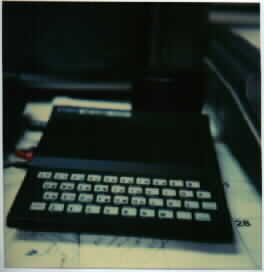
Timex-Sinclair 1000

The Timex/Sinclair 1000 was the first computer I ever owned. It was both fascinating and frustrating. Granted, computers have come a long way since that time, but it was too undependable to be of great value to me. My first dependable machine was a 64K Tandy (Radio Shack) Color Computer 2. In the future I will post a page about that machine.
I bought the machine on clearance at a Kmart store shortly after Timex decided to pull out of the home computer business. The Timex/Sinclair broke new ground by being the first complete, assembled, programmable computer for under $100. I paid even less. I paid $26 for the computer, and additional $14 dollars for the optional 16K memory upgrade. The memory packs originally sold for $50. Timex also sold programs for the computer on cassette tape, and a small thermal printer. The printer listed for $100.
The Timex/Sinclair 1000 is a near twin to the Sinclair ZX-81. The only real differences are minor changes in some keyboard labeling ,(RUBOUT on the Sinclair is DELETE on the Timex), and the Timex version has 2K of RAM standard vs. 1K of RAM on the Sinclair. The Sinclair ZX-81 was a brainchild of Clive Sinclair, an Englishman who had introduced the earlier groundbreaking ZX-80 computer, an earlier miniature television, and other high tech products to the public.
The computer featured a flat membrane keyboard. It is hard to tell from this picture but the unit is about the size of a paperback book. The main unit is very light. The computer is powered by a supplied 9V AC to DC adapter. Also furnished is a neat little owners manual with programming help, and a set of patch cords for hooking the computer to a portable cassette recorder. Also supplied is a switch box for hooking the computer to a television. Yes, a basic monaural portable cassette usually works best. You supply the recorder, and also a television. Since the computer displays only in black and white, a 9 or 12 inch b/w portable tv works out fine.
Optional accessories like memory packs, printers, etc., all hook to the computer at an exposed edge connector at the rear of the machine. There were many accessories made for the Sinclair and Timex/Sinclair computer by third party manufacturers. Optional full-sized keyboards, disk drive systems, and 64K RAM packs to name just a few. If you ever get the chance, check out a SYNCH magazine. I'm sure they are out of print now(?), and you will see a mind boggling array of improvements for the Sinclair family of computers.
One interesting feature of the Timex was the way it used its keyboard. There were different modes. If the cursor had a "K" in it, you were in keyword mode. That meant, for example, pushing the P key would type the basic keyword "print" on your screen. There were other modes, including a graphics mode, which was indicated by a "G" in the cursor. The computer didn't have true graphics, but would display different patterns of graphic characters you could program.
One reason that Timex/Sinclair 1000 and Sinclair
ZX-81 computers were so inexpensive was the computers were designed using
the smallest number of components possible. Saving money is a good thing,
and I believe simplicity is a good thing, but often you end up sacrificing
performance. One of the better examples of how the cost cutting affected
things was in the way the computer handled video output to the screen.
The computer had a slow mode, and it also had a fast mode. When you turned
the computer on, you would start in slow mode. You could switch modes back
and forth using "fast" and "slow" commands in basic. The computer was usually
several times faster when operating in fast mode.
In fast mode you give up having a display while the computer
is calculating. In slow mode, you always have a display. Slow mode sacrifices
performance because the Timex/Sinclair has to use its Z-80 microprocessor
to keep the screen updated. More expensive computers usually have
dedicated video systems which take care of the screen, leaving the CPU
free to run programs faster.
The main problem I had with the computer was it was often prone to crash. I believe the computer would move slightly and also bend just enough from using the keyboard, that the computer would lose connection to the memory pack. When this happened you would lose everything in the computers' memory. Even if all your work was saved you could end up waiting up to 10 minutes to reload it all from tape. Some companies sold special cradles to prevent this. Some people sold flexible ribbon cables to connect accessories to the computer. I never tried my luck with either of those, though I suspect the cable would probably cure most of the crashing.
I have heard that there are still many users who are tremendously loyal to these machines, especially in England, where they were developed. As much as I admired the concept of such an innovative, low-cost computer, I fear its shortcomings may have turned off some users who might have been successful with a little bit better machine.